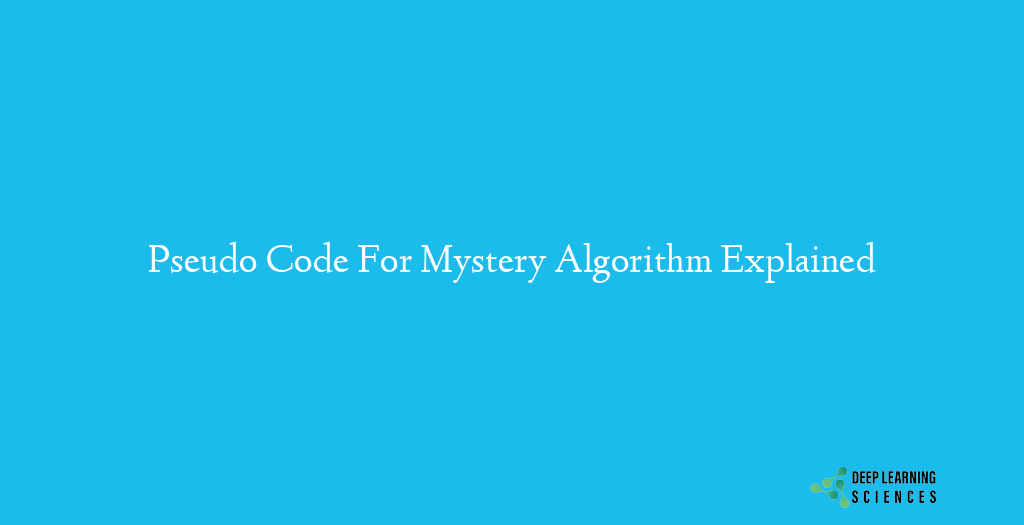In this article on Deep Learning, we will talk about Pseudo Code For Mystery Algorithm, which will be explained to remove all the doubts.

Mystery Algorithm
An algorithm is any well-defined computational procedure that takes some value, a set of some value, as input and produces some value, or a set of values as output. Algorithms are like road-mapping techniques for completing and successfully a given, well-defined task. Even a simple function for adding two numbers is problem-solving, in a sense. If you want to bake a cake the steps are Preheat the oven; mix flour, eggs, and sugar and pour into a baking pan; and so forth. This is basically a set of instructions is what we call a recipe. Recipes tell you how to complete successfully a task by performing a number of steps. Problem-solving techniques are like recipes.” Except, in this case, they are recipes prepared by humans for use by programmers and Computer devices.
The word “algorithm” can be traced to the 9th century by the Persian astronomer and mathematician Abdullah Muhammad bin Musa al-Khwarizmi, best known as “The father of Algebra.” His last name al-Khwarizmi when Latinized produced the word “algoritmi.”
The algorithms were the domain of mathematicians like Alan Turing, who helped break the unbreakable German “Enigma” code in World War II. Then it became the domain of computer experts programmer. From problem-solving techniques to the Facebook algorithm even algorithmic warfare the use of algorithms has crisscrossed every facet of life. The internet runs on many algorithms. Smartphone apps are nothing but algorithms. Email knows where to go thanks to algorithms. Computer and video games are algorithmic storytelling. All those views and postings on social media are brought to you based on algorithms.
Because of the simplicity of algorithms,” says the blog Memory. “and because we perceive them as being free from any type of bug, they must be they behave so well that they cannot be criticized. when it comes to making reviews and decisions. But this is not true. ML (Machine learning) algorithms can only do what they’re taught. And since they are developed and trained by humans, human flaws will incapably slink in. Distorted structure and unstructured data, incorrect logic, or the biases of human programmers, mean problem solving cannot only replicate human biases they can intensify them, too.”
And Hannah Fry, a mathematician at University College London, argues that we need to be paying more attention to the expert programming them. “Algorithms are making huge of data consequential decisions in our public on everything from transportation to medicine to welfare benefits to criminal justice. Yet the public knows almost nothing about them and even less about the engineers and programmers who are creating them behind the scenes.
Also Read: Algorithm For Rubik’s Cube: 4 Must-Know Algorithms
They are changing programmer life in all sorts of ways. From what we select to read and watch to who we choose to date, algorithms are increasingly involved in a huge role. We entered these algorithms or problem solving into our courtrooms and our School and our hospital, and they are making decisions on our behalf that are subtly shifting the way our society is operating.
“They are not perfect, and often consist of the biases of the people who created them. We should not blindly trust many algorithms, but we also should not dismiss them altogether. They are incredibly consistent. They never get tired, and they’re absolutely accurate. The problem is that algorithms do not understand context or expression. They do not understand emotion and empathy in the way that humans do,” she explains.
Consider the following procedure that is taken as input array and two indices.
Pseudocode for the Mystery Algorithm
- Input two integers: a, b.
- Initialize the value of x to a and the value of y to b.
- If x>y then set x to x-y.
- If x=y then set y to y-x.
- Repeat steps 3 and 4 until x=y.
- Output x (or y) and halt.
The code is explained below.
1. First of all algorithm output in step six if we begin with a = 2437, b = 875
2. Pick ONE option
- 3
- 0
- 4
- 5
- 3
- 7
875 2437
Outout Pseudo Code For Mystery Algorithm
A Mystery
a) procedure MYSTERY(A, l, r)
b) range := r − l + 1
c) subrange := d2 · range/3e4
d) if range = 2 and A[l] > A[r] then
e) swap A[l] ↔ A[r]
f) else if range ≥ 3 then 7
g) MYSTERY(A, l, l + subrange − 1)
h) MYSTERY(A, r − (subrange − 1), r)
i) MYSTERY(A, l, l + subrange − 1)
j) end if
k) end procedure
A. mystery(a1 , a2 , . . . an : array of real numbers)
B. k = 1
C. bk = a1
D. for i = 2 to n
E. c = 0
F. for j = 1 to i − 1
G. c = aj + c
H. if (ai ≥ c)
I. k = k + 1
J. bk = ai
K. return b1 , b2 , . . . , bk
L. public int[] foo(int[] a) {
M. int k=1;
N. int nSize=10;
O. int[] b=new int[nSize];
P. b[k]=a[1];
Q. for (int i=2;i=c){
V. k=k+1;
W. b[k]=a[i];
Conclusion
Algorithms define how a particular task is to be performed. They provide computing devices with instructions and programs. They tell computers on assembly lines how specific parts should be put together. Or they evaluate application forms and recommend the best candidates.